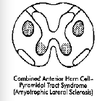Clinical Evaluation of Spinal Cord Flashcards
Myelopathy definition
Disorder resulting in spinal cord dysfunction
Nerve root definition
Combined sensory and motor rami of the spinal cord (e.g. L5)
Spinal tracts definition
Axons that travel in the spinal cord to relay information. (e.g. corticospinal tract).
Dermatome definition
Cutaneous area served by an individual sensory root.
Myotome definition
Muscles innervated by an individual motor root.
Radiculopathy definition
Sensory and/or motor dysfunction due to injury to a nerve root.
Intervertebral foramen definition
Opening formed by 2 adjacent vertebral bodies through which the nerve roots travel.
Paresthesia definition
An abnormal sensation, can include burning, pricking, tickling, or tingling
Dysesthesia definition
Impairment of sensation short of anesthesia
Hyperesthesia definition
Abnormal acuteness of sensitivity to touch, pain, or other sensory stimuli
Step-by-step approach to clinical evaluation of the spinal cord
- sx from hx and PE
- define UMN vs. LMN
- define tracts involved
- define anatomic sites involved
- differential dx
- workup
Spinothalamic tract: fxn and crossing point
- -Function: Sensory modalities of pain (pinprick) and temperature-cold/hot
- -Cross: 2-3 segments above root entry level in anterior spinal cord
Posterior/Dorsal Column: fxn and crossing point
- -Function: Sensory modalities of vibration, position, and 2-pt discrim
- -Cross: medulla (brain stem)
Corticospinal tract: fxn and crossing point
- -Function: Motor function
- -Cross: Lower medulla (brain stem)
Nerve root levels
- 8 cervical
- 12 thoracic
- 5 lumbar
- 5 sacral
- 1 coccyx
Conus medullaris level/definition
- located @~L1-L2 vertebrae where the spinal cord ends
- made up of S2-S5 spinal cord segments
Cauda equina definition
- formed by LS roots
- begins @ ~L1/L2 where the











